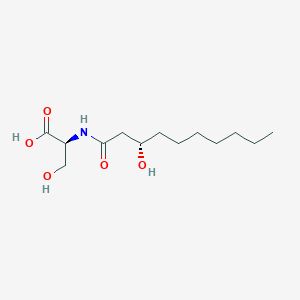
|
Serratamic acid |
Serratamic acid is a lipid of Fatty Acyls (FA) class. |
12 |

|
acetic acid |
acetic acid is a lipid of Fatty Acyls (FA) class. Acetic acid is associated with abnormalities such as Vitamin B 12 Deficiency. The involved functions are known as Excretory function. The related lipids are Propionate. |
89633 |
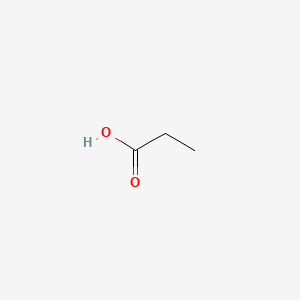
|
propionic acid |
propionic acid is a lipid of Fatty Acyls (FA) class. Propionic acid is associated with abnormalities such as Epilepsy, Infection, Tuberculosis, Alkalosis and Ischemia. The involved functions are known as Uptake, Biosynthetic Pathways, Methylation, Protein Overexpression and Biochemical Pathway. Propionic acid often locates in Body tissue, Cytoplasmic matrix, Membrane, Protoplasm and Extracellular. The associated genes with propionic acid are TRIO gene, TRRAP gene, SLC5A8 gene, SLC33A1 gene and Homologous Gene. The related lipids are Fatty Acids, Propionate, butyrate, Valerates and mycocerosic acid. |
7360 |

|
butyric acid |
butyric acid is a lipid of Fatty Acyls (FA) class. Butyric acid is associated with abnormalities such as PARKINSON DISEASE, LATE-ONSET, Colitis, Autoimmune Diseases, Inflammatory Bowel Diseases and PARAGANGLIOMAS 2. The involved functions are known as DNA Methylation, Transcription, Genetic, chromatin modification, Gene Expression and Gene Silencing. Butyric acid often locates in Membrane, Chromatin Structure, Chromosomes, viral nucleocapsid location and Ribosomes. The associated genes with butyric acid are Locus, Genes, Dominant, Genes, rRNA, Genome and Chromatin. The related lipids are Butyrates, butyrate, Promega, Butyric Acids and Butyric Acid. |
9358 |
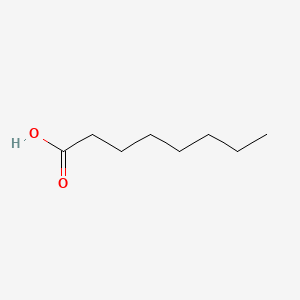
|
octanoic acid |
octanoic acid is a lipid of Fatty Acyls (FA) class. Octanoic acid is associated with abnormalities such as Ischemia, Diabetes Mellitus, Non-Insulin-Dependent, Diabetes, Cardiomyopathies and Obesity. The involved functions are known as Anabolism, 5-(carboxyamino)imidazole ribonucleotide mutase activity, Citric Acid Cycle, Metabolic Inhibition and Excretory function. Octanoic acid often locates in Pore, Protoplasm, Endothelium, Mitochondria and Muscle. The associated genes with octanoic acid are P4HTM gene, CPT1A gene, HADH gene, ACSL1 Gene and CD36 gene. The related lipids are Fatty Acids, Nonesterified Fatty Acids, Oleates, Palmitates and hexanoic acid. |
3349 |
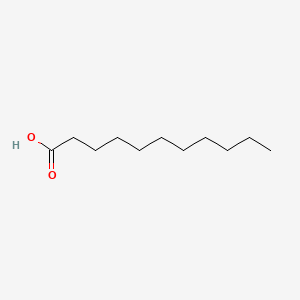
|
UNDECANOIC ACID |
UNDECANOIC ACID is a lipid of Fatty Acyls (FA) class. The involved functions are known as Anabolism, Mitosis, Transcriptional Activation, Mismatch Repair and Transcription, Genetic. Undecanoic acid often locates in Protoplasm and spindle microtubule. The associated genes with UNDECANOIC ACID are TERT gene. The related lipids are Fatty Acids and undecanoic acid. |
246 |
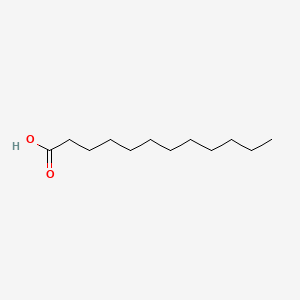
|
lauric acid |
lauric acid is a lipid of Fatty Acyls (FA) class. Lauric acid is associated with abnormalities such as Infection, Renal tubular disorder, Hypertensive disease, Obesity and Mycoses. The involved functions are known as Transcription, Genetic, Signal Transduction, Mutation, metaplastic cell transformation and Anabolism. Lauric acid often locates in Skin, Plasma membrane, Cytoplasmic matrix, Body tissue and Palmar surface. The associated genes with lauric acid are Gene Family, SLC33A1 gene, Homologous Gene, Open Reading Frames and P4HTM gene. The related lipids are Fatty Acids, Oleic Acids, Palmitates, Stearates and 9,11-linoleic acid. |
3691 |
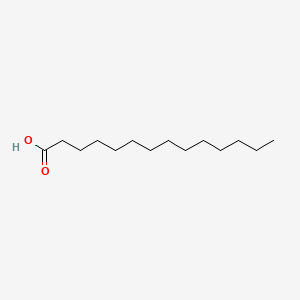
|
Tetradecanoic acid |
Tetradecanoic acid is a lipid of Fatty Acyls (FA) class. Tetradecanoic acid is associated with abnormalities such as Chronic lung disease, Infection, Spastic syndrome, Diabetes and Cardiovascular Diseases. The involved functions are known as Fatty acid biosynthetic process, Anabolism, lung alveolus development, 5-(carboxyamino)imidazole ribonucleotide mutase activity and Homeostasis. Tetradecanoic acid often locates in Structure of parenchyma of lung, Blood, Head, Membrane and Cytoplasmic matrix. The associated genes with Tetradecanoic acid are SLC33A1 gene, SFTPA1 gene, P4HTM gene, Polypeptides and GPR132 gene. The related lipids are Fatty Acids, Nonesterified Fatty Acids, palmitoleic acid, Phosphatidylglycerols and Butanols. |
5058 |

|
stearic acid |
stearic acid is a lipid of Fatty Acyls (FA) class. Stearic acid is associated with abnormalities such as Helminthiasis, Exanthema, Chronic disease, Obesity and Dyslipidemias. The involved functions are known as acyltransferase activity, Mutation, Cell division, cell fate and Fatty Acid Metabolism. Stearic acid often locates in membrane fraction, Mouse Liver, Membrane, Body tissue and Endoplasmic reticulum, membrane. The associated genes with stearic acid are Homologous Gene, ACLY gene, Transgenes, FATE1 gene and Alleles. The related lipids are Lysophospholipids, Stearic acid, Fatty Acids, cis-vaccenic acid and Phosphatidylserines. The related experimental models are Knock-out. |
5692 |
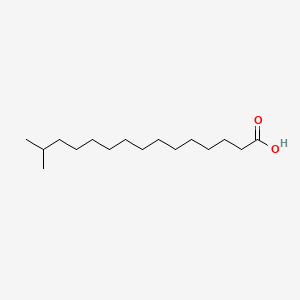
|
Isohexadecanoic acid |
Isohexadecanoic acid is a lipid of Fatty Acyls (FA) class. The related lipids are Palmitates, Stearates, Propionate and Butyrates. |
23 |
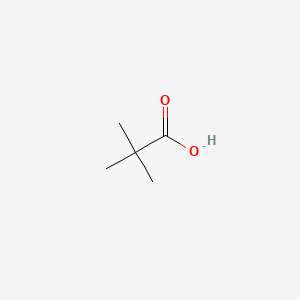
|
Pivalic acid |
Pivalic acid is a lipid of Fatty Acyls (FA) class. Pivalic acid is associated with abnormalities such as Renal carnitine transport defect, Carnitine deficiency, Urinary tract infection, Otitis Media and Chronic infectious disease. The involved functions are known as carnitine transport, Uptake, inhibitors, Oxidation and Intestinal Absorption. Pivalic acid often locates in Grey line. The related lipids are pivalic acid and Fatty Acids. |
411 |
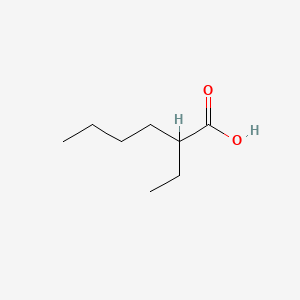
|
2-ETHYLHEXANOIC ACID |
2-ETHYLHEXANOIC ACID is a lipid of Fatty Acyls (FA) class. The involved functions are known as Steroid biosynthesis, cholesterol metabolic process, cholesterol transport, Cell Proliferation and progesterone biosynthetic process. 2-ethylhexanoic acid often locates in Organelles, Tissue membrane, Mitochondria, Mitochondrial Membranes and Cytoplasm. The associated genes with 2-ETHYLHEXANOIC ACID are steroidogenic acute regulatory protein and SLC27A1 gene. The related lipids are 2-ethylhexanoic acid, Steroids, Hexanols and (22R)-22-hydroxycholesterol. |
248 |
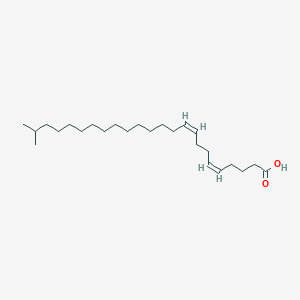
|
23-methyl-5Z,9Z-tetracosadienoic acid |
23-methyl-5Z,9Z-tetracosadienoic acid is a lipid of Fatty Acyls (FA) class. |
2 |

|
Arachidonic acid |
Arachidonic acid is a lipid of Fatty Acyls (FA) class. Arachidonic acid is associated with abnormalities such as Atherosclerosis, Ischemia, Hypertensive disease, Hypertension induced by pregnancy and Vascular ring of aorta. The involved functions are known as Platelet aggregation, Anabolism, Ion Transport, Signal Transduction Pathways and Signal. Arachidonic acid often locates in Extracellular, Body tissue, Protoplasm, Tissue membrane and soluble. The associated genes with Arachidonic acid are CYP2J2 gene, CYP2E1 gene, Recombinant Proteins, POR gene and P4HTM gene. The related lipids are Fatty Acids, Glycerophospholipids, Steroids, octadecadienoic acid and 9-hydroxy-10,12-octadecadienoic acid. The related experimental models are Mouse Model and Knock-out. |
22864 |

|
Linoelaidic acid |
Linoelaidic acid is a lipid of Fatty Acyls (FA) class. Linoelaidic acid is associated with abnormalities such as Obesity, Diabetes Mellitus, Non-Insulin-Dependent, Pneumonia, Chronic Obstructive Airway Disease and Metabolic syndrome. The involved functions are known as Metabolic Inhibition, Steroid biosynthesis, Signal Transduction, Insulin Resistance and Inflammation. Linoelaidic acid often locates in Mitochondria, Membrane and Cytoplasmic matrix. The associated genes with Linoelaidic acid are FFAR1 gene, C9orf7 gene, TNF gene, CCL2 gene and TLR4 gene. The related lipids are Fatty Acids, octadecadienoic acid, Steroids, methyl linoleate and Cyanoketone. |
10058 |

|
Linoleic acid |
Linoleic acid is a lipid of Fatty Acyls (FA) class. Linoleic acid is associated with abnormalities such as Diabetes Mellitus, Non-Insulin-Dependent, Metabolic syndrome, Obesity, Chronic Obstructive Airway Disease and Pneumonia. The involved functions are known as Insulin Resistance, Inflammation, Synthesis, Pathological accumulation of air in tissues and cytokine biosynthesis. The associated genes with Linoleic acid are TNF gene, CCL2 gene and TLR4 gene. The related lipids are palmitoleic acid, nervonic acid and Sphingolipids. |
5699 |

|
alpha-linolenic acid |
Alpha-linolenic acid is a lipid of Fatty Acyls (FA) class. Alpha-linolenic acid is associated with abnormalities such as Coronary heart disease, abnormal fragmented structure, Arterial thrombosis and Subarachnoid Hemorrhage. The involved functions are known as Anabolism, Signal, Transcription, Genetic, Saturated and Regulation. Alpha-linolenic acid often locates in Blood, Body tissue, Plasma membrane, Hepatic and peroxisome. The associated genes with alpha-linolenic acid are FATE1 gene, volicitin, CYP2U1 gene, CYP1A2 gene and CYP2J2 gene. The related lipids are Fatty Acids, Dietary Fatty Acid, stearidonic acid and Fatty Acids, Nonesterified. |
4231 |

|
DHA |
Dha is a lipid of Fatty Acyls (FA) class. Dha is associated with abnormalities such as Atherosclerosis, Consumption-archaic term for TB, Chronic disease, Cardiovascular Diseases and Diabetes Mellitus, Non-Insulin-Dependent. The involved functions are known as Inflammation, Oxidation, fatty acid oxidation, Fatty Acid Metabolism and Lipid Metabolism. Dha often locates in Hepatic, Protoplasm, Mucous Membrane, Epithelium and outer membrane. The associated genes with DHA are IMPACT gene, FATE1 gene, GAPDH gene, THOC4 gene and SLC33A1 gene. The related lipids are stearidonic acid, Fatty Acids, Total cholesterol, Lipopolysaccharides and Dietary Fatty Acid. The related experimental models are Mouse Model, Transgenic Model, Animal Disease Models and Arthritis, Experimental. |
11054 |
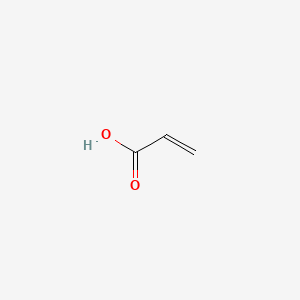
|
Acrylic acid |
Acrylic acid is a lipid of Fatty Acyls (FA) class. Acrylic acid is associated with abnormalities such as Wiskott-Aldrich Syndrome. The involved functions are known as Diastasis, Oxidation, Metabolic Inhibition, Fermentation and Anabolism. Acrylic acid often locates in Back, Blood, Entire bony skeleton and Transplanted tissue. The associated genes with Acrylic acid are GJA1 gene and FADD gene. The related lipids are Fatty Acids, Decanoates and Fatty Acids, Nonesterified. |
2898 |
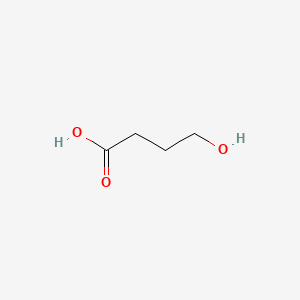
|
4-hydroxy-butyric acid |
4-hydroxy-butyric acid is a lipid of Fatty Acyls (FA) class. |
3927 |

|
Pyruvic acid |
Pyruvic acid is a lipid of Fatty Acyls (FA) class. |
27047 |
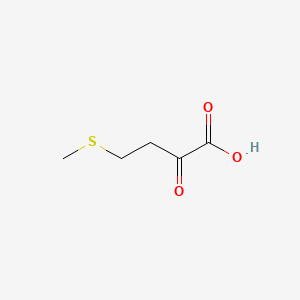
|
4-methylthio-2-oxobutanoic acid |
4-methylthio-2-oxobutanoic acid is a lipid of Fatty Acyls (FA) class. The involved functions are known as polyamine biosynthetic process, Anabolism, enzyme activity, enzyme pathway and Process. The associated genes with 4-methylthio-2-oxobutanoic acid are 2-keto-4-methylthiobutyric acid, MTAP gene, Homologous Gene, 2-keto-4-thiomethylbutyrate and Alleles. The related lipids are alpha-ketocaproic acid. |
289 |
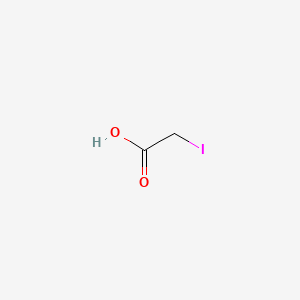
|
Iodoacetic acid |
Iodoacetic acid is a lipid of Fatty Acyls (FA) class. Iodoacetic acid is associated with abnormalities such as Photoreceptor degeneration and Post MI. The involved functions are known as Hypoxia, Glycolysis, Metabolic Inhibition, Oxidation and PTPS activity. Iodoacetic acid often locates in Extracellular, Muscle, Mitochondria, Cytoplasmic matrix and Tissue membrane. The associated genes with Iodoacetic acid are SLC33A1 gene, GTF2I gene, Mutant Proteins, TRIM33 gene and oxytocin, 1-desamino-(O-Et-Tyr)(2)-. |
3688 |

|
6-aminohexanoic acid |
6-aminohexanoic acid is a lipid of Fatty Acyls (FA) class. 6-aminohexanoic acid is associated with abnormalities such as Blood Clot, Myocardial Infarction, Cerebrovascular accident, Renal impairment and Scoliosis, unspecified. The involved functions are known as Fibrinolysis, Agent, Hemorrhage, plasminogen activation and inhibitors. 6-aminohexanoic acid often locates in Chest, Blood, Body tissue, peritoneal and Plasma membrane. The associated genes with 6-aminohexanoic acid are P4HTM gene, BSND gene, MTPN gene, NDUFS4 gene and Homologous Gene. The related lipids are Phosphatidylserines and Butyric Acid. |
3685 |

|
4-aminobutyric acid |
4-aminobutyric acid is a lipid of Fatty Acyls (FA) class. 4-aminobutyric acid is associated with abnormalities such as Epilepsy and Premenstrual syndrome. The involved functions are known as Binding (Molecular Function), neuron survival, Process, Uptake and physiological aspects. 4-aminobutyric acid often locates in Microglial, Neurofilament, Neuraxis, Brain region and Neurites. The associated genes with 4-aminobutyric acid are arginine methyl ester, SLC33A1 gene, NKS1 gene, P4HTM gene and ITSN2 gene. The related lipids are pregnenolone sulfate, pregnane-20-one, Pregnanes, Steroids and endogenous steroids. |
19702 |

|
Lipoic acid |
Lipoic acid is a lipid of Fatty Acyls (FA) class. |
7940 |
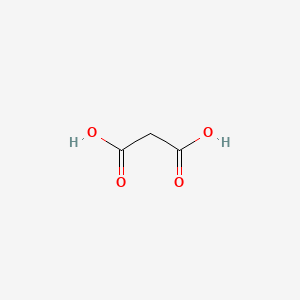
|
Malonic acid |
Malonic acid is a lipid of Fatty Acyls (FA) class. Malonic acid is associated with abnormalities such as Malonic aciduria. The involved functions are known as Vmax, Regulation, Biochemical Pathway, Citric Acid Cycle and intermediary metabolism. Malonic acid often locates in Body tissue, Mitochondria, soluble and NADH dehydrogenase complex. The associated genes with Malonic acid are ACACA gene, ACSF3 gene, Recombinant Proteins, NKS1 gene and Homologous Gene. The related lipids are Fatty Acids and Butyric Acid. |
3587 |
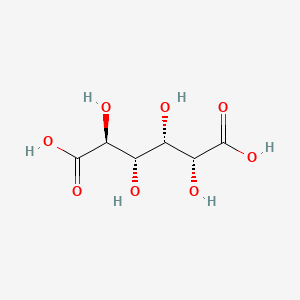
|
Glucaric acid |
Glucaric acid is a lipid of Fatty Acyls (FA) class. Glucaric acid is associated with abnormalities such as Consumption-archaic term for TB and furuncle. The involved functions are known as Oxidation, Mutation, Process, Cell Growth and Anabolism. Glucaric acid often locates in BL21, Clone and host. The associated genes with Glucaric acid are MIOX gene, ISYNA1 gene, Genome and Candidate Disease Gene. The related experimental models are Knock-out. |
1814 |
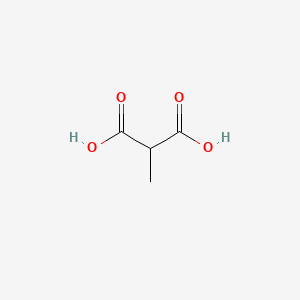
|
Methylmalonic acid |
Methylmalonic acid is a lipid of Fatty Acyls (FA) class. Methylmalonic acid is associated with abnormalities such as Vitamin B 12 Deficiency, Osteoporosis, Anemia, Anemia, Megaloblastic and Renal impairment. The involved functions are known as Abnormal renal function, Lactation, physiological aspects, phosphoglycerate dehydrogenase activity and Excretory function. Methylmalonic acid often locates in Entire bony skeleton, Blood, Protoplasm, Muscle and Body tissue. The associated genes with Methylmalonic acid are IMPACT gene, ACSF3 gene, CBLC gene, MMADHC gene and LMBRD1 gene. The related lipids are Fatty Acids and Butanols. |
3174 |
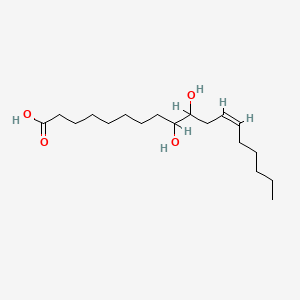
|
9,10-DiHOME |
9,10-dihome is a lipid of Fatty Acyls (FA) class. |
1159 |

|
PGD2 |
Pgd2 is a lipid of Fatty Acyls (FA) class. Pgd2 is associated with abnormalities such as Inflammatory disorder, Pleurisy, Rhinitis, Dehydration and Pneumonia. The involved functions are known as antagonists, fat cell differentiation, Phosphorylation, Process and Gene Expression. Pgd2 often locates in Cell surface, Body tissue, Extracellular, Bone Marrow and Membrane. The associated genes with PGD2 are oxytocin, 1-desamino-(O-Et-Tyr)(2)-, P4HTM gene, PTGS2 gene, PTGDS gene and IL3 gene. The related lipids are 15-deoxyprostaglandin J2, Nonesterified Fatty Acids, Lipopolysaccharides, Steroids and Liposomes. The related experimental models are Knock-out and Rodent Model. |
6464 |
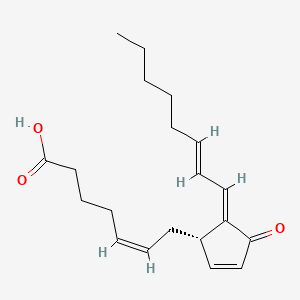
|
15-deoxy-delta-12,14-PGJ2 |
15-deoxy-delta-12,14-pgj2 is a lipid of Fatty Acyls (FA) class. 15-deoxy-delta-12,14-pgj2 is associated with abnormalities such as Dehydration and Myocardial Ischemia. The involved functions are known as Binding (Molecular Function), Inflammation, Alveolar ventilation function, Stimulus and Process. 15-deoxy-delta-12,14-pgj2 often locates in Cytosol, Myocardial tissue and Heart tissue. The associated genes with 15-deoxy-delta-12,14-PGJ2 are Homologous Gene and G-substrate. The related lipids are 15-deoxyprostaglandin J2 and Lipopolysaccharides. |
1201 |

|
11beta-PGF2 |
11beta-pgf2 is a lipid of Fatty Acyls (FA) class. |
15009 |
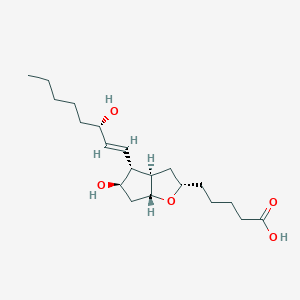
|
6beta-pgi1 |
6beta-pgi1 is a lipid of Fatty Acyls (FA) class. |
16 |

|
Leukotriene b4 |
Leukotriene b4 is a lipid of Fatty Acyls (FA) class. The involved functions are known as Chemotaxis, release of sequestered calcium ion into cytoplasm and Polymerization. Leukotriene b4 often locates in Protoplasm. The associated genes with Leukotriene b4 are phallacidin. |
9311 |

|
Thromboxane b2 |
Thromboxane b2 is a lipid of Fatty Acyls (FA) class. Thromboxane b2 is associated with abnormalities such as endothelial dysfunction, Diabetes Mellitus, Non-Insulin-Dependent, Diabetes Mellitus, Ischemia and Thrombocytosis. The involved functions are known as Platelet Activation, Excretory function, Anabolism, Inflammation and mRNA Expression. Thromboxane b2 often locates in Endothelium, Hepatic and Microsomes, Liver. The associated genes with Thromboxane b2 are PTGS2 gene, prothrombin fragment 2 and CCL14 wt Allele. |
10175 |
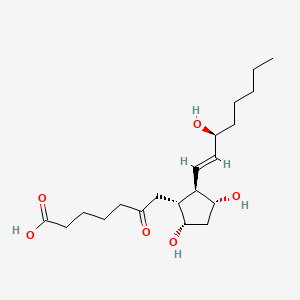
|
6-keto-pgf1alpha |
6-keto-pgf1alpha is a lipid of Fatty Acyls (FA) class. |
3430 |
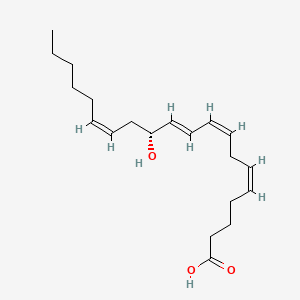
|
12(r)-hete |
12(r)-hete is a lipid of Fatty Acyls (FA) class. |
1079 |
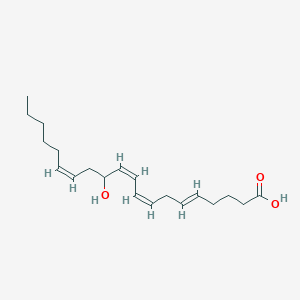
|
12-hete |
12-hete is a lipid of Fatty Acyls (FA) class. |
1452 |
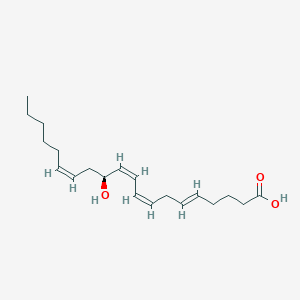
|
12-hydroxyeicosatetraenoic acid |
12-hydroxyeicosatetraenoic acid is a lipid of Fatty Acyls (FA) class. 12-hydroxyeicosatetraenoic acid is associated with abnormalities such as Endothelial dysfunction, Stable angina, Diabetes and Ischemia. The involved functions are known as Inflammation, Protective Agents, inhibitors, Signal Transduction and Extravasation. 12-hydroxyeicosatetraenoic acid often locates in Endothelium, Integumentary system, Articular system, Tissue fiber and Knee. The related lipids are 9-hydroxy-10,12-octadecadienoic acid, 13-hydroperoxy-9,11-octadecadienoic acid, hydroxy fatty acid and DOPE. |
1073 |
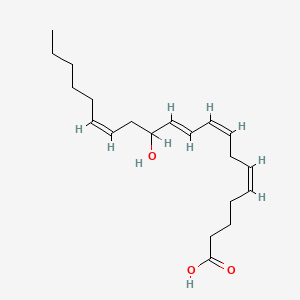
|
12-HETE |
12-HETE is a lipid of Fatty Acyls (FA) class. 12-HETE is associated with abnormalities such as Endothelial dysfunction, Stable angina, Diabetes and Ischemia. The involved functions are known as Inflammation, Protective Agents, Exocytosis, inhibitors and Signal Transduction. 12-HETE often locates in Endothelium, Integumentary system, Articular system, Tissue fiber and Knee. The related lipids are 9-hydroxy-10,12-octadecadienoic acid, 13-hydroperoxy-9,11-octadecadienoic acid, hydroxy fatty acid and DOPE. |
1073 |
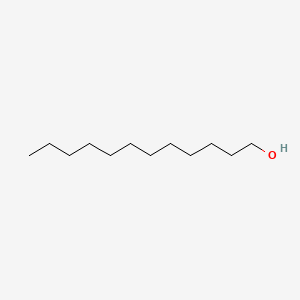
|
1-dodecanol |
1-dodecanol is a lipid of Fatty Acyls (FA) class. |
676 |
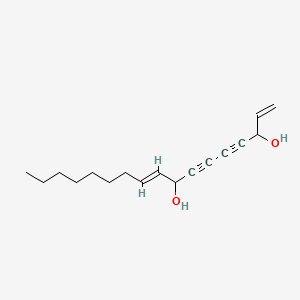
|
Falcarindiol |
Falcarindiol is a lipid of Fatty Acyls (FA) class. Falcarindiol is associated with abnormalities such as Contact Dermatitis and Immune System Diseases. The involved functions are known as Delayed Hypersensitivity, Immune Tolerance, Stimulus, Metabolic Inhibition and Biochemical Pathway. Falcarindiol often locates in Cell surface, Abdomen and Bone Marrow. The associated genes with Falcarindiol are CD276 Antigen, VTCN1 gene, RELB gene, L1RE1 gene and ICOSLG gene. The related lipids are Lipopolysaccharides. |
106 |
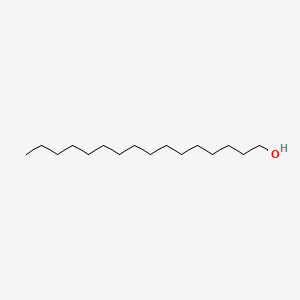
|
Cetyl alcohol |
Cetyl alcohol is a lipid of Fatty Acyls (FA) class. |
511 |
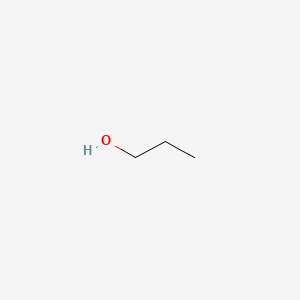
|
1-propanol |
1-propanol is a lipid of Fatty Acyls (FA) class. |
6697 |
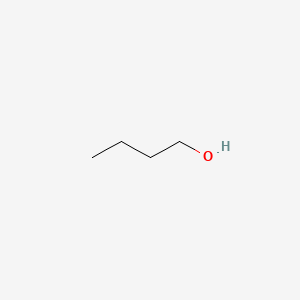
|
1-butanol |
1-butanol is a lipid of Fatty Acyls (FA) class. |
5925 |
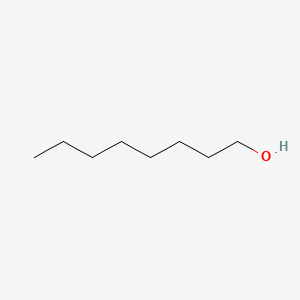
|
n-octanol |
N-octanol is a lipid of Fatty Acyls (FA) class. N-octanol is associated with abnormalities such as Wiskott-Aldrich Syndrome. The involved functions are known as Mutation and Detergents. N-octanol often locates in Tissue membrane. The related lipids are Octanols and 1-Octanol. |
3305 |

|
4-hydroxynonenal |
4-hydroxynonenal is a lipid of Fatty Acyls (FA) class. 4-hydroxynonenal is associated with abnormalities such as Chronic disease, Obesity, Diabetes, Acquired Immunodeficiency Syndrome and Lung diseases. The involved functions are known as protein expression, Glycolysis, mRNA Expression, Regulation and Mitochondrion in division. 4-hydroxynonenal often locates in Muscle, Mitochondria, Adipose tissue, Head and Mouse Muscle. The associated genes with 4-hydroxynonenal are STAT3 gene, SIRT1 gene, PGC gene, IL6 gene and cytochrome c''. The related lipids are Lipopolysaccharides, Lipid Peroxides, Promega, Membrane Lipids and oxidized lipid. The related experimental models are Mouse Model, Knock-out, Transgenic Model, Disease model and Rodent Model. |
5685 |
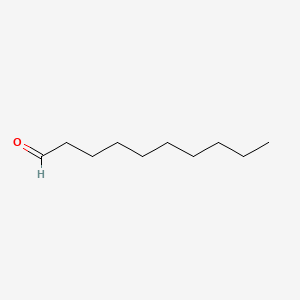
|
Capraldehyde |
Capraldehyde is a lipid of Fatty Acyls (FA) class. |
422 |

|
Hexane |
Hexane is a lipid of Fatty Acyls (FA) class. |
9183 |

|
(e,e,e,e)-squalene |
(e,e,e,e)-squalene is a lipid of Fatty Acyls (FA) class. (e,e,e,e)-squalene is associated with abnormalities such as Hypercholesterolemia and Cataract. The involved functions are known as Process, metaplastic cell transformation, Protein Overexpression, Anabolism and Biosynthetic Pathways. (e,e,e,e)-squalene often locates in Membrane, Protoplasm, Plasma membrane, Tissue membrane and Back. The associated genes with (e,e,e,e)-squalene are Genome, IMPACT gene, GAPDH gene, GTF2I gene and Chromatin. The related lipids are Membrane Lipids, cycloartenol, Sterols, Fatty Acids and Nonesterified Fatty Acids. |
1766 |
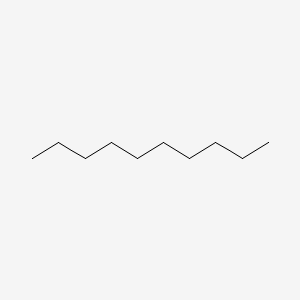
|
Decane |
Decane is a lipid of Fatty Acyls (FA) class. |
1934 |
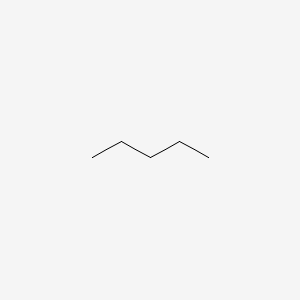
|
Pentane |
Pentane is a lipid of Fatty Acyls (FA) class. |
2265 |
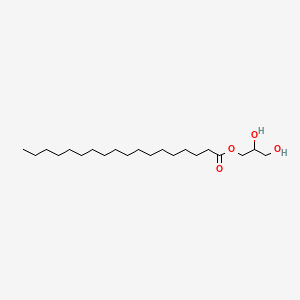
|
Glyceryl monostearate |
Glyceryl monostearate is a lipid of Glycerolipids (GL) class. |
353 |
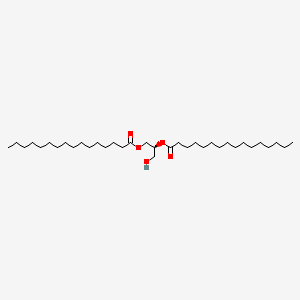
|
1,2-Dipalmitoyl-sn-glycerol |
1,2-Dipalmitoyl-sn-glycerol is a lipid of Glycerolipids (GL) class. |
29 |
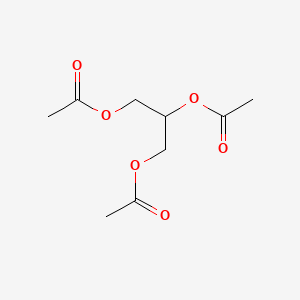
|
triacetin |
triacetin is a lipid of Glycerolipids (GL) class. Triacetin is associated with abnormalities such as Vesicular Exanthema of Swine and Lobomycosis. The involved functions are known as National Institute for Occupational Safety and Health (U.S.), Softening, esterase activity, Process and Cell Growth. Triacetin often locates in Tissue fiber, Cell surface and Cytoplasmic matrix. The associated genes with triacetin are GRAP2 gene and Immobilized Proteins. The related lipids are Labrafil M 1944 CS, ethyl oleate and glyceryl monostearate. |
371 |
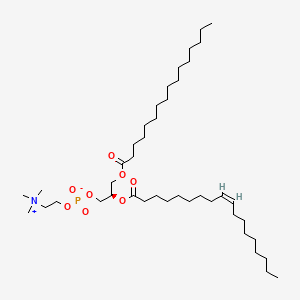
|
POPC |
POPC is a lipid of Glycerophospholipids (GP) class. Popc is associated with abnormalities such as Hyperlipidemia, Atherosclerosis, Type I Mucolipidosis, Coronary Arteriosclerosis and Coronary Artery Disease. The involved functions are known as phosphoglycerate dehydrogenase activity, Denaturation, immunoreactivity, high-density lipoprotein particle remodeling and Process. Popc often locates in high-density lipoprotein particle, viral nucleocapsid location, Plasma membrane, spherical high-density lipoprotein particle and Face. The associated genes with POPC are Mutant Proteins, SCARB1 gene, SPEN gene, Polypeptides and globular protein. The related lipids are Total cholesterol, i-cholesterol, Fatty Acids, cholesteryl oleate and Cholesterol/Phospholipid. The related experimental models are Genetically Engineered Mouse. |
3550 |
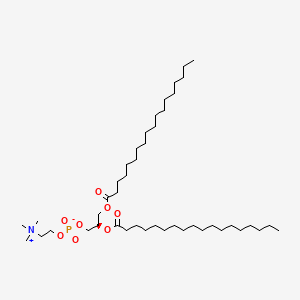
|
816-94-4 |
816-94-4 is a lipid of Glycerophospholipids (GP) class. 816-94-4 is associated with abnormalities such as Gigantism, Pulmonary Hypertension, Neutropenia, Serum Sickness and Urticaria. The involved functions are known as pulmonary effects, Hemodynamics, Stereochemistry, Host defense and Blood Circulation. 816-94-4 often locates in vesicle, Blood, biological membrane, soluble and Cardiopulmonary. The associated genes with 816-94-4 are pentaglobulin, EMILIN1 gene and FASTK Gene. The related lipids are Liposomes, dimyristoylphosphatidylglycerol, Lipopolysaccharides, Unilamellar Liposomes and Unilamellar Vesicles. |
828 |
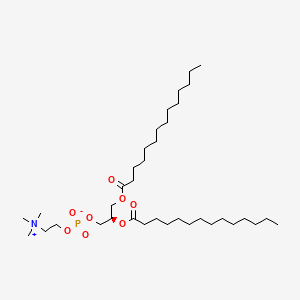
|
18194-24-6 |
18194-24-6 is a lipid of Glycerophospholipids (GP) class. 18194-24-6 is associated with abnormalities such as Cerebrovascular accident, Renal tubular disorder, Atherosclerosis, Hyperlipoproteinemia Type III and Lipid Metabolism Disorders. The involved functions are known as Process, protein folding, Catalyst, Biochemical Pathway and Fold in Medical Device Material. 18194-24-6 often locates in Tissue membrane, Membrane, periplasm, vesicle membrane and outer membrane. The associated genes with 18194-24-6 are Integral Membrane Proteins, Protein Structure, RTN4 gene, RTN4R gene and Protein, Organized by Structure. The related lipids are Micelles, dimyristoylphosphatidylglycerol, 1,2-dihexadecyl-sn-glycero-3-phosphocholine, Unilamellar Vesicles and cholesteryl oleate. The related experimental models are Mouse Model, Arthritis, Adjuvant-Induced, Disease model and Xenograft Model. |
6350 |
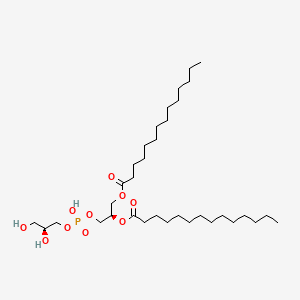
|
DMPG |
DMPG is a lipid of Glycerophospholipids (GP) class. Dmpg is associated with abnormalities such as Infection, Malaria, Dehydration, Gigantism and Abnormal shape. The involved functions are known as Signal Transduction, Binding (Molecular Function), inhibitors, Agent and Light Scattering. Dmpg often locates in Membrane, integral to membrane, Blood, Protoplasm and Face. The associated genes with DMPG are synthetic peptide, Amino Acids, Basic, Homologous Gene, Integral Membrane Proteins and penetratin. The related lipids are Lipopolysaccharides, dimyristoylphosphatidylglycerol, Micelles, Fatty Acids and Liposomes. |
639 |
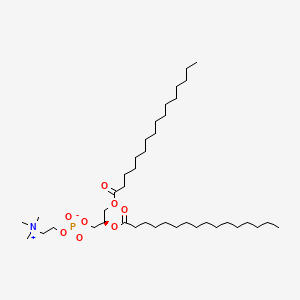
|
Colfosceril palmitate |
Colfosceril palmitate is a lipid of Glycerophospholipids (GP) class. Colfosceril palmitate is associated with abnormalities such as Entrapment, gaucher's, Dehydration and Gigantism. The involved functions are known as Drug Interactions, Process, Entropy, Force and Transferring. Colfosceril palmitate often locates in Membrane, Cell membrane, Tissue membrane, Lipid Bilayers and Cellular Membrane. The associated genes with Colfosceril palmitate are B 43. The related lipids are 1,2-oleoylphosphatidylcholine, 1,2-dipalmitoylphosphatidylglycerol and Sterols. |
161 |
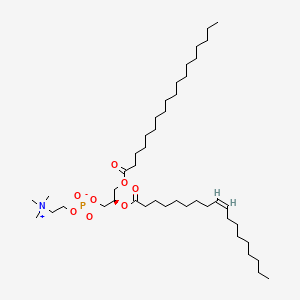
|
SOPC |
SOPC is a lipid of Glycerophospholipids (GP) class. Sopc is associated with abnormalities such as Gigantism. The involved functions are known as Anabolism, Pressure- physical agent, cell transformation, enzyme activity and Molecular Dynamics. Sopc often locates in Plasma membrane, Membrane, Tissue membrane, Lipid Bilayers and Microsomes. The associated genes with SOPC are THOC4 gene, Integral Membrane Proteins and peptide L. The related lipids are Liposomes, Unilamellar Vesicles, 1,2-oleoylphosphatidylcholine, Sphingolipids and Sterols. |
183 |
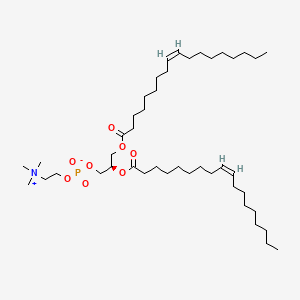
|
1,2-Dioleoyl-sn-Glycero-3-Phosphocholine |
1,2-Dioleoyl-sn-Glycero-3-Phosphocholine is a lipid of Glycerophospholipids (GP) class. 1,2-dioleoyl-sn-glycero-3-phosphocholine is associated with abnormalities such as Exanthema, Renal tubular disorder, Nodule, Gigantism and Mycoses. The involved functions are known as Lysis, Encapsulation, Process, Uptake and Flow or discharge. 1,2-dioleoyl-sn-glycero-3-phosphocholine often locates in Cytoplasmic matrix, Endosomes, soluble, Endoplasmic Reticulum and Membrane. The associated genes with 1,2-Dioleoyl-sn-Glycero-3-Phosphocholine are P4HTM gene, synthetic peptide, BCAR1 gene, PCNA gene and CNTNAP1 gene. The related lipids are Liposomes, 1,2-oleoylphosphatidylcholine, 1,2-distearoylphosphatidylethanolamine, Butanols and Cardiolipins. The related experimental models are Mouse Model and Xenograft Model. |
3428 |
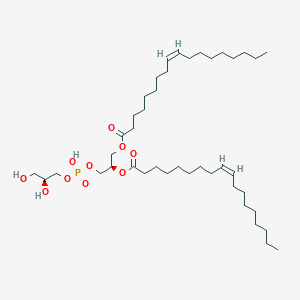
|
PG(18:1(9Z)/18:1(9Z)) |
PG(18:1(9Z)/18:1(9Z)) is a lipid of Glycerophospholipids (GP) class. Pg(18:1(9z)/18:1(9z)) is associated with abnormalities such as Neonatal hemochromatosis, Renal tubular disorder, Hereditary pancreatitis and UDPglucose 4-epimerase deficiency disease. The involved functions are known as Genetic Translation Process, Regulation, Saturated, enzyme activity and Cytokinesis. Pg(18:1(9z)/18:1(9z)) often locates in Membrane, soluble, Tissue membrane, membrane fraction and Thylakoid Membrane. The associated genes with PG(18:1(9Z)/18:1(9Z)) are COIL gene, P4HTM gene, GRAP2 gene, Integral Membrane Proteins and synthetic peptide. The related lipids are Liposomes, Fatty Acids, Sphingolipids, DOPE and 1,2-oleoylphosphatidylcholine. |
437 |
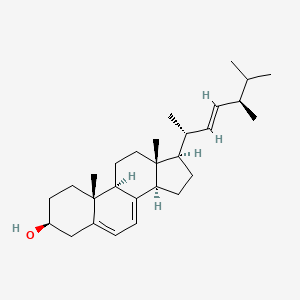
|
Ergosterol |
Ergosterol is a lipid of Sterol Lipids (ST) class. Ergosterol is associated with abnormalities such as Disintegration (morphologic abnormality), Consumption-archaic term for TB, Candidiasis, Mycoses and Iodotyrosyl coupling defect. The involved functions are known as Anabolism, sporulation, 5-(carboxyamino)imidazole ribonucleotide mutase activity, Subtraction process and Physiologic Organization. Ergosterol often locates in Pore, Membrane, Protoplasm, Plasma membrane and Endoplasmic Reticulum. The associated genes with Ergosterol are IMPACT gene, BLVRB gene, CYP51A1 gene, CDR1 wt Allele and HM13 gene. The related lipids are Sterols, Cardiolipins, Membrane Lipids, fecosterol and Phosphatidylserines. The related experimental models are Knock-out. |
2200 |

|
Platelet activating factor |
Platelet activating factor is a lipid of Glycerophospholipids (GP) class. Platelet activating factor is associated with abnormalities such as Atherosclerosis, Acute cholecystitis without calculus, Cholecystitis, Colitis and Cholecystitis, Acute. The involved functions are known as Cell Survival, Metabolic Inhibition, lipid oxidation, Apoptosis and Oxidation. Platelet activating factor often locates in soluble, Cellular Membrane, Smooth muscle (tissue), Intima and Tissue specimen. The associated genes with Platelet activating factor are apolipoprotein A-I Milano, Homologous Gene, TSPO gene, HBEGF gene and SLC33A1 gene. The related lipids are Hydroxycholesterols, Liposomes, 25-hydroxycholesterol, Lysophosphatidylcholines and Lipopolysaccharides. The related experimental models are Knock-out, Mouse Model and Transgenic Model. |
7383 |
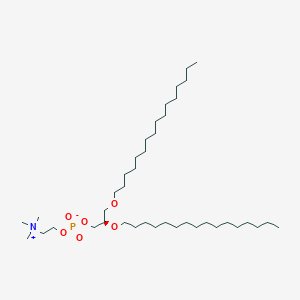
|
36314-47-3 |
36314-47-3 is a lipid of Glycerophospholipids (GP) class. 36314-47-3 is associated with abnormalities such as protrusion, Dehydration, Spastic syndrome, Communicable Diseases and Renal tubular disorder. The involved functions are known as Process, Binding (Molecular Function), Noise, Laser-generated electromagnetic radiation and protonation. 36314-47-3 often locates in Protoplasm, Back, Membrane, Extracellular and Lipid Bilayers. The associated genes with 36314-47-3 are Polylysine, FASTK Gene, synthetic peptide, Protein Structure and Polypeptides. The related lipids are Liposomes, Micelles, 1,2-dihexadecyl-sn-glycero-3-phosphocholine, dioleoyl phosphatidylethanolamine and Lysophosphatidylcholines. |
294 |
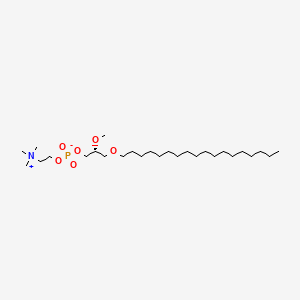
|
ET-18-OCH3 |
ET-18-OCH3 is a lipid of Glycerophospholipids (GP) class. Et-18-och3 is associated with abnormalities such as Morphologically altered structure, Choline Deficiency, Acquired partial lipodystrophy and Punctate inner choroidopathy. The involved functions are known as Mutation, establishment and maintenance of localization, Uptake, Increased Sensitivy and Process. Et-18-och3 often locates in Plasma membrane, Membrane, Back, Protoplasm and Endoplasmic Reticulum. The associated genes with ET-18-OCH3 are Genome, Alleles, ATP8A1 gene, Homologous Gene and ATPase Gene. The related lipids are Phosphatidylserines, Sphingolipids, Lysophosphatidylcholines, Phospholipid Ethers and Phosphatidate. The related experimental models are Knock-out. |
794 |
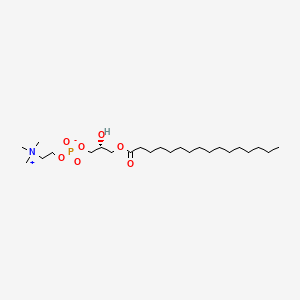
|
1-Palmitoyl-sn-glycero-3-phosphocholine |
1-Palmitoyl-sn-glycero-3-phosphocholine is a lipid of Glycerophospholipids (GP) class. 1-palmitoyl-sn-glycero-3-phosphocholine is associated with abnormalities such as Intrahepatic Cholestasis and Dysentery, Shigella dysenteriae. The involved functions are known as Homeostasis, Signal Transduction, Saturated, mRNA Expression and Synthesis. 1-palmitoyl-sn-glycero-3-phosphocholine often locates in Hepatic. The associated genes with 1-Palmitoyl-sn-glycero-3-phosphocholine are PPARA gene, TGFBR2 gene, SMAD3 gene and PLA2G6 gene. The related lipids are Fatty Acids, palmitoyl lysophosphatidylcholine, LYSO-PC and 1-palmitoyl-2-hydroxy-sn-glycero-3-phosphocholine. |
135 |
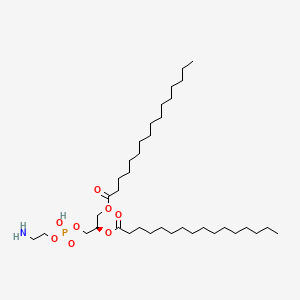
|
923-61-5 |
923-61-5 is a lipid of Glycerophospholipids (GP) class. 923-61-5 is associated with abnormalities such as Gigantism, Hyperostosis of skull, BOSLEY-SALIH-ALORAINY SYNDROME, Anemia, Sickle Cell and Amyloidosis. The involved functions are known as Protein Binding, Anabolism, Signal Transduction, Detergents and Genetic Translation Process. 923-61-5 often locates in soluble, Tissue membrane, brush border membrane, Mouse Kidney and Plasma membrane. The associated genes with 923-61-5 are THEMIS gene, SLC33A1 gene, P4HTM gene, Integral Membrane Proteins and Protein Structure. The related lipids are 1,2-oleoylphosphatidylcholine, Unilamellar Vesicles, Membrane Lipids, DOPE and Micelles. |
755 |

|
PE(15:0/20:0) |
PE(15:0/20:0) is a lipid of Glycerophospholipids (GP) class. Pe(15:0/20:0) is associated with abnormalities such as Exanthema, Infection, Painful Bladder Syndrome, Obesity and Fatty Liver. The involved functions are known as conjugation, Transcription, Genetic, Sinking, Autophagy and Protein Biosynthesis. Pe(15:0/20:0) often locates in membrane fraction, soluble, Membrane, Body tissue and Tissue membrane. The associated genes with PE(15:0/20:0) are GABARAPL2 gene, ATG10 gene, ATG12 gene, SLC33A1 gene and GABARAP gene. The related lipids are Liposomes, Lipopolysaccharides, Phosphatidylserines, Membrane Lipids and Cardiolipins. The related experimental models are Knock-out and Cancer Model. |
723 |
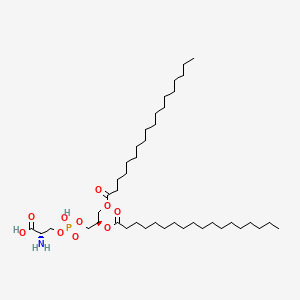
|
51446-62-9 |
51446-62-9 is a lipid of Glycerophospholipids (GP) class. 51446-62-9 is associated with abnormalities such as Virus Diseases, Infection, Bacterial Infections, Communicable Diseases and Exanthema. The involved functions are known as Phagocytosis, Obstruction, Binding (Molecular Function), targeting and inhibitors. 51446-62-9 often locates in Head, Clone, Cell membrane, Cell surface and host. The associated genes with 51446-62-9 are Homologous Gene, Orthologous Gene, Fusion Protein, ETV3 gene and Amino Acids, Basic. The related lipids are Phosphatidylserines, Lipopolysaccharides, 1-palmitoyl-2-oleoylphosphatidylethanolamine, beta-amyrin and Membrane Lipids. |
1744 |

|
1-Oleoyl Lysophosphatidic Acid |
1-Oleoyl Lysophosphatidic Acid is a lipid of Glycerophospholipids (GP) class. 1-oleoyl lysophosphatidic acid is associated with abnormalities such as Myocardial Infarction, early pregnancy, Scleroderma, Blind Vision and Hyperlipidemia. The involved functions are known as Agent, Blood coagulation, Selection, Genetic, Analyte and Biological Processes. 1-oleoyl lysophosphatidic acid often locates in Tissue specimen, Body tissue, Blood, Membrane and Skin. The associated genes with 1-Oleoyl Lysophosphatidic Acid are Mucin-16, Peptides, SMAD4 gene, RND1 gene and Polypeptides. The related lipids are lysophosphatidic acid, A(2)C, Lysophospholipids, Fatty Acids and sphingosine 1-phosphate. The related experimental models are Mouse Model, Knock-out, Cancer Model, Xenograft Model and Arthritis, Adjuvant-Induced. |
3463 |

|
tacrolimus |
Tacrolimus is a lipid of Polyketides (PK) class. Tacrolimus is associated with abnormalities such as Renal glomerular disease. The involved functions are known as inhibitors, Fungicidal activity, Metabolic Inhibition, Excretory function and Dephosphorylation. Tacrolimus often locates in Hepatic, Mitochondrial matrix and Inner mitochondrial membrane. The associated genes with Tacrolimus are RHOA gene and BGN gene. |
12730 |
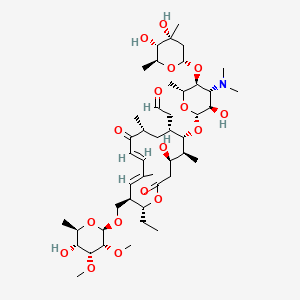
|
Tylosin |
Tylosin is a lipid of Polyketides (PK) class. Tylosin is associated with abnormalities such as Mastitis, Bovine, Infection, Bacterial Infections, Arthritis and Ileitis. The involved functions are known as Anabolism, acireductone dioxygenase [iron(II)-requiring] activity, Protein Biosynthesis, Mastitis and Methylation. Tylosin often locates in Ribosomes, Cell Wall, 50S ribosomal subunit, Ribosome Subunits, Large and Ribosome Subunits. The associated genes with Tylosin are Gene Clusters, Genome, resistance genes, Homologous Gene and HM13 gene. The related experimental models are Knock-out. |
1035 |

|
erythromycin |
erythromycin is a lipid of Polyketides (PK) class. Erythromycin is associated with abnormalities such as Systemic Inflammatory Response Syndrome, Pneumonia, Infection, Pneumococcal Infections and Exanthema. The involved functions are known as Pharmacodynamics, Sterility, Agent, Drug Kinetics and Adjudication. Erythromycin often locates in Blood, peritoneal, Extracellular, Ribosomes and apicoplast. The associated genes with erythromycin are P4HTM gene, SLC33A1 gene, FAM3B gene, Operon and Homologous Gene. The related lipids are Hydroxytestosterones, Steroids, Propionate, Mycolic Acids and campesterol. The related experimental models are Mouse Model and Knock-out. |
19871 |

|
Azithramycine |
Azithramycine is a lipid of Polyketides (PK) class. Azithramycine is associated with abnormalities such as Respiratory Tract Infections, Pneumonia, Lower respiratory tract infection, Infection and Nonspecific urethritis. The involved functions are known as Lysis, Selection, Genetic, Mutation, Relapse and Adaptation. Azithramycine often locates in Blood, Respiratory System, Genitourinary system, Back and Chest. The associated genes with Azithramycine are Genes, rRNA, Genome, RPL22 gene, OPRM1 gene and tryptic soy broth. The related lipids are Liposomes, Phosphatidylserines, Promega, Lipopolysaccharides and Steroids. The related experimental models are Mouse Model, Knock-out and Tissue Model. |
7835 |

|
clarithromycin |
clarithromycin is a lipid of Polyketides (PK) class. Clarithromycin is associated with abnormalities such as Helicobacter Pylori Infection, Infection, Coinfection, Gastritis and Peptic Ulcer. The involved functions are known as Point Mutation, Increased Sensitivy, Bacterial resistance, urease activity and Mutation. Clarithromycin often locates in Blood, Gastric mucosa, Biopsy sample, Respiratory System and Entire gastrointestinal tract. The associated genes with clarithromycin are Genes, rRNA, rRNA Operon, Genome, HM13 gene and GDF15 gene. The related lipids are 9,11-linoleic acid, Steroids, Lysophosphatidylcholines, Lipopolysaccharides and 4-hydroxycholesterol. The related experimental models are Mouse Model, Knock-out and Experimental Pneumococcal Meningitis. |
10449 |

|
ZEARALENONE |
ZEARALENONE is a lipid of Polyketides (PK) class. Zearalenone is associated with abnormalities such as HYPOTRICHOSIS, LOCALIZED, AUTOSOMAL RECESSIVE, 2, Estrogen excess, Food-Drug Interactions, Osteomalacia and Osteoporosis. The involved functions are known as mRNA Expression, Metabolic Inhibition, Phosphorylation, Agent and Transcriptional Activation. Zearalenone often locates in Gastrointestinal tract structure, soluble, viral nucleocapsid location, Spindle and Hepatic. The associated genes with ZEARALENONE are Candidate Disease Gene, Genome, Genes, Reporter, P4HTM gene and Open Reading Frames. The related lipids are Lipopolysaccharides, Steroids, Fatty Acids and Promega. The related experimental models are Transgenic Model. |
2573 |

|
nystatin |
nystatin is a lipid of Polyketides (PK) class. Nystatin is associated with abnormalities such as Virus Diseases, Infection, Candidiasis, Leukopenia and Mycoses. The involved functions are known as Membrane Potentials, Uptake, Flow or discharge, Cell membrane potential and adenine transport. Nystatin often locates in Cell Wall, Plasma membrane, Extracellular, Membrane and Virion. The associated genes with nystatin are Genome, Integral Membrane Proteins, Amino Acids, Basic, P4HTM gene and Homologous Gene. The related lipids are Sterols, Liposomes, Membrane Lipids, Sphingolipids and 1,2-oleoylphosphatidylcholine. The related experimental models are Knock-out and Xenograft Model. |
4890 |

|
Nystatin A3 |
Nystatin A3 is a lipid of Polyketides (PK) class. Nystatin a3 is associated with abnormalities such as Mycoses, Candidiasis of the genitals and Gigantism. The involved functions are known as Drug Interactions, Process, Synthesis, Fermentation and Anabolism. Nystatin a3 often locates in Cell membrane, Membrane, Protoplasm, Entire oral cavity and integral to membrane. The associated genes with Nystatin A3 are Gene Clusters. The related lipids are Sterols, 1,2-oleoylphosphatidylcholine, Membrane Lipids, DOPE and N-caproylsphingosine. |
2059 |

|
CYTOCHALASIN B |
CYTOCHALASIN B is a lipid of Polyketides (PK) class. Cytochalasin b is associated with abnormalities such as Renal tubular disorder and Chagas Disease. The involved functions are known as Membrane Protein Traffic, inhibitors, Metabolic Inhibition, Biochemical Pathway and Increased Sensitivy. Cytochalasin b often locates in Cytoplasmic matrix, Plasma membrane, Microtubules, Extracellular and Protoplasm. The associated genes with CYTOCHALASIN B are SLC2A2 gene, PFDN5 gene, SLC2A1 gene, OMG gene and SPEN gene. The related lipids are Steroids, Lipopolysaccharides and Liposomes. The related experimental models are Xenograft Model. |
9648 |
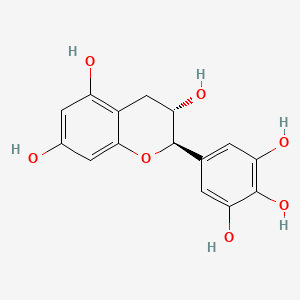
|
Gallocatechin |
(+)-gallocatechin is a lipid of Polyketides (PK) class. The involved functions are known as inhibitors and Cell Survival. The associated genes with (+)-Gallocatechin are TERT gene. |
778 |

|
(-)-Epigallocatechin |
(-)-Epigallocatechin is a lipid of Polyketides (PK) class. The involved functions are known as Protective Agents, inhibitors, Process, Drug Kinetics and Fermentation. (-)-epigallocatechin often locates in Hepatic, Blood, Membrane, Back and apical membrane. The associated genes with (-)-Epigallocatechin are ADRBK1 gene and FASTK Gene. The related lipids are 1,2-dilinolenoyl-3-(4-aminobutyryl)propane-1,2,3-triol. The related experimental models are Rodent Model and Transgenic Model. |
1282 |

|
(-)-Epigallocatechin gallate |
(-)-Epigallocatechin gallate is a lipid of Polyketides (PK) class. (-)-epigallocatechin gallate is associated with abnormalities such as IMMUNE SUPPRESSION, Infection, Nodule, Lymphopenia and Tumor Immunity. The involved functions are known as Apoptosis, Cellular Immune Response, Specific immune response, Signal and Infiltration. (-)-epigallocatechin gallate often locates in Immune system, Cytoplasmic Granules, Skin, Protoplasm and Body tissue. The associated genes with (-)-Epigallocatechin gallate are C8orf4 gene, Genes, vpr, MAPK8 gene, P4HTM gene and GAG Gene. The related lipids are Promega, Lipopolysaccharides, Palmitates, Fatty Acids and Sphingolipids. The related experimental models are Mouse Model, Xenograft Model, Transgenic Model, Experimental Autoimmune Encephalomyelitis and Arthritis, Collagen-Induced. |
6551 |

|
Amentoflavone |
Amentoflavone is a lipid of Polyketides (PK) class. The involved functions are known as Metabolic Inhibition, Selection, Genetic and Agent. The associated genes with Amentoflavone are ODAM gene, DIS3 gene and SAPC gene. |
331 |

|
SCHEMBL105486 |
Kakonein is a lipid of Polyketides (PK) class. Kakonein is associated with abnormalities such as Fatty Liver, Chronic liver disease, Morphologically altered structure, Hypertensive disease and Cardiovascular Diseases. The involved functions are known as protein expression, Extravasation, Liver damage, mRNA Expression and cell activation. Kakonein often locates in Body tissue, Hepatic, Microvilli, Cytoplasm and Membrane. The associated genes with Kakonein are TJP1 gene, CD14 gene, iberiotoxin, AT-Rich Interactive Domain-Containing Protein 1A and NKS1 gene. The related lipids are dehydrosoyasaponin I and Steroids. The related experimental models are Knock-out. |
1391 |

|
rotenone |
rotenone is a lipid of Polyketides (PK) class. Rotenone is associated with abnormalities such as Parkinson Disease, MYOPATHY, DISTAL, WITH ANTERIOR TIBIAL ONSET, Neurodegenerative Disorders, Septicemia and Respiratory Failure. The involved functions are known as Phosphorylation, Process, Cell Death, proteasome activity and Apoptosis. Rotenone often locates in Protoplasm, Presynaptic Terminals, Neurites, NADH dehydrogenase complex and Mitochondria. The associated genes with rotenone are DNAJB9 gene, EIF2S3 gene, Candidate Disease Gene, G-substrate and ERN1 gene. The related lipids are Lipopolysaccharides, Membrane Lipids, Phosphatidylserines, Fatty Acids and Cardiolipins. The related experimental models are Knock-out, Mouse Model, Disease model and Rodent Model. |
7079 |
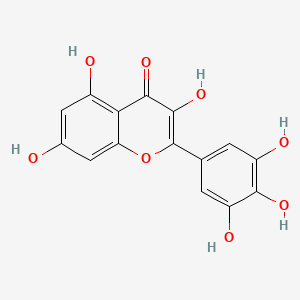
|
myricetin |
myricetin is a lipid of Polyketides (PK) class. Myricetin is associated with abnormalities such as Diabetes, First myocardial infarction, Diabetes Mellitus, Non-Insulin-Dependent, Asthma and Cataract. The involved functions are known as Cell Survival, inhibitors, Process, Metabolic Inhibition and Oxidation. Myricetin often locates in Fibril - cell component, soluble, Body tissue, Back and Tissue membrane. The associated genes with myricetin are HPGDS gene, P4HTM gene, CFLAR gene, SLC2A2 gene and SLC2A1 gene. The related lipids are Promega, Sterols, dipalmitoylphosphatidylserine, 1,2-oleoylphosphatidylcholine and Membrane Lipids. |
1801 |
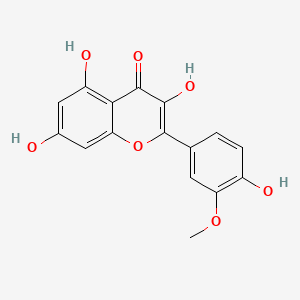
|
Isorhamnetin |
Isorhamnetin is a lipid of Polyketides (PK) class. Isorhamnetin is associated with abnormalities such as Facial Hemiatrophy, Colitis, endothelial dysfunction, Morphologically altered structure and Diabetes. The involved functions are known as enzyme activity, Methylation, Anabolism, Binding (Molecular Function) and Vmax. Isorhamnetin often locates in Body tissue, Cytoplasmic, Mucous Membrane, Cytoplasm and Human tissue. The associated genes with Isorhamnetin are CSK gene, RPS6KA3 gene, Mitogen-activated protein, NCF1 gene and Chromatin. The related lipids are Fatty Acids, Phosphatidylserines and Palmitates. The related experimental models are Mouse Model, Xenograft Model and Streptozotocin Diabetes. |
1015 |

|
quercetin |
quercetin is a lipid of Polyketides (PK) class. Quercetin is associated with abnormalities such as Coronary heart disease, Myocardial Infarction, Cirrhosis, Coronary Arteriosclerosis and Vascular ring. The involved functions are known as Vasodilation, physiological aspects, Fermentation, Process and Ingredient. Quercetin often locates in Arterial system, Endothelium, Skin, Endothelium, Vascular and Tissue specimen. The associated genes with quercetin are P4HTM gene, SULT gene, UGT1A1 gene, ARHGAP26 gene and PLXNB1 gene. The related lipids are blood lipid, Promega, Steroids, Phosphatidylserines and Fatty Acids. The related experimental models are Knock-out, Mouse Model, Xenograft Model, Tissue Model and Cancer Model. |
5377 |
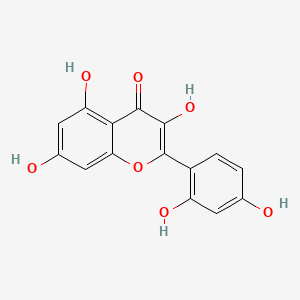
|
morin |
morin is a lipid of Polyketides (PK) class. Morin is associated with abnormalities such as Colitis, Hyperuricemia, Gout, Parkinson Disease and Rheumatoid Arthritis. The involved functions are known as establishment and maintenance of localization, Binding (Molecular Function), Uptake, Increased Sensitivy and Cell Cycle Arrest. Morin often locates in Cell Wall, apoplast, Plasma membrane, Cytoplasmic matrix and Membrane. The associated genes with morin are GADD45A gene, MAPK8 gene, ODAM gene, TNFRSF1A gene and ALPP gene. The related lipids are Lipopolysaccharides, Butyrates, Fatty Acids, Nonesterified, Palmitates and Oleates. |
1499 |

|
apigenin |
apigenin is a lipid of Polyketides (PK) class. Apigenin is associated with abnormalities such as Morphologically altered structure, Chimera disorder, Hypertensive disease, infection induced and Infection. The involved functions are known as inhibitors, Gene Expression, Process, Metabolic Inhibition and Cell Death. Apigenin often locates in Vacuole, Cytoplasmic matrix, Cytoplasm, Tissue membrane and Membrane. The associated genes with apigenin are MSMP gene, BCL2 gene, PTGS2 gene, Chromatin and SLC33A1 gene. The related lipids are Lipopolysaccharides, Steroids, 1-Butanol, agosterol A and Butyrates. The related experimental models are Mouse Model, Tissue Model, Knock-out, Xenograft Model and Disease model. |
4250 |

|
luteolin |
luteolin is a lipid of Polyketides (PK) class. Luteolin is associated with abnormalities such as Morphologically altered structure, Nodule, retinal toxicity, CLEFT LIP, CONGENITAL HEALED and Ischemia. The involved functions are known as Metabolic Inhibition, Cell Death, Caspase Activation, activation of protein kinase C activity by G-protein coupled receptor protein signaling pathway and protein kinase C activity. Luteolin often locates in Mitochondria, Cell-Free System, Protoplasm, Membrane and Body tissue. The associated genes with luteolin are BCL2 gene, TNFSF10 gene, BCL2L1 gene, XIAP gene and MCL1 gene. The related lipids are Lipopolysaccharides, Sterols, blood lipid, Fatty Acids and Steroids. The related experimental models are Xenograft Model, Mouse Model, Experimental Autoimmune Encephalomyelitis, Knock-out and Cancer Model. |
3284 |

|
FLAVONE |
FLAVONE is a lipid of Polyketides (PK) class. Flavone is associated with abnormalities such as Cardiovascular Diseases, Cerebrovascular accident, DERMATITIS HERPETIFORMIS, FAMILIAL, Hyperinsulinism and Inflammatory disorder. The involved functions are known as Oxidation-Reduction, Metabolic Inhibition, Inflammation, Phosphorylation and antioxidant activity. Flavone often locates in Endothelium, Hepatic, Protoplasm, Body tissue and Extracellular. The associated genes with FLAVONE are ICAM1 gene, BCL2L1 gene, MYC gene, TP53 gene and cytochrome c''. The related lipids are Promega, Steroids and Total cholesterol. The related experimental models are Knock-out, Disease model and Animal Disease Models. |
2093 |
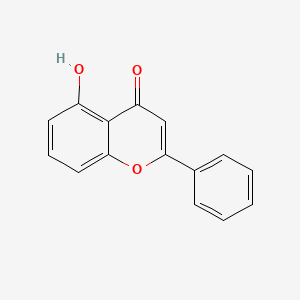
|
5-Hydroxyflavone |
5-Hydroxyflavone is a lipid of Polyketides (PK) class. |
55 |

|
baicalein |
baicalein is a lipid of Polyketides (PK) class. Baicalein is associated with abnormalities such as Neurodegenerative Disorders, Fibrillation, Hypertensive disease, Aortic coarctation and Coronary Occlusion. The involved functions are known as Anabolism, Polymerization, Process, inhibitors and Pathogenesis. Baicalein often locates in Membrane, Lipid Bilayers, soluble, Cell-Free System and Protoplasm. The associated genes with baicalein are P4HTM gene, BIRC5 gene, TSPO gene, SHOC2 gene and XIAP gene. The related lipids are Fatty Acids, Nonesterified Fatty Acids, iodoresiniferatoxin, Lipopolysaccharides and 17-octadecynoic acid. The related experimental models are Knock-out, Mouse Model and Parkinsonism, Experimental. |
1997 |
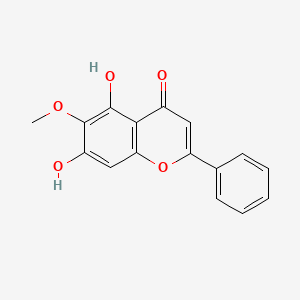
|
Oroxylin A |
Oroxylin A is a lipid of Polyketides (PK) class. |
180 |
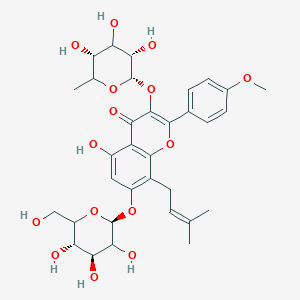
|
LMPK12112009 |
LMPK12112009 is a lipid of Polyketides (PK) class. |
216 |
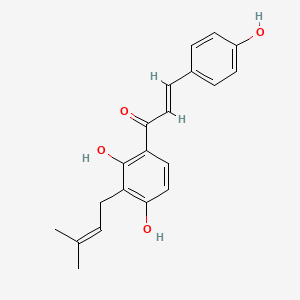
|
Isobavachalcone |
Isobavachalcone is a lipid of Polyketides (PK) class. The involved functions are known as inhibitors. |
57 |



































































































